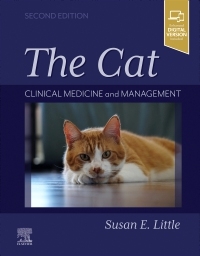
Hospice and Palliative Care for Companion Animals
Wiley-Blackwell (Verlag)
978-1-119-80878-7 (ISBN)
Animals with life-limiting illnesses deserve compassionate, thoughtful, end-of-life care. Their caregivers and families, faced with the loss of a beloved companion, deserve empathy, support, and education, to guide them through an emotionally wrenching period and provide their companion animals with the highest possible quality of life. In recent years, the ethics of care and service to sick and dying animals and their caregivers has been the subject of considerable attention.
»Hospice and Palliative Care for Companion Animals«, 2nd Edition provides a thorough update to the first and only complete guide to this field of service, its foundations, and its applications. It addresses the needs of pets, caregivers, and veterinary professionals alike, including fundamental ethical and emotional principles as well as detailed discussion of specific illnesses and life-limiting conditions. The expanded second edition incorporates cutting-edge research into animal behavior and cognition to enrich the reader’s understanding of companion animals’ emotional needs and their experience of illness and death.
»Hospice and Palliative Care for Companion Animals«, 2nd Edition readers will also find:
- Existing chapters expanded to incorporate new research and practical experience
- New chapters discussing factors underlying the decision to euthanize, the potential role of ethology in palliative care, and more
- A companion website with educational handouts for use in veterinary practices
»Hospice and Palliative Care for Companion Animals« is an indispensable resource for caregivers and veterinary professionals alike.
Amir Shanan, DVM, is the Founding President of the International Association for Animal Hospice and Palliative Care and a Founding Partner of the Animal Hospice Group. He owns Compassionate Veterinary Hospice, a veterinary practice dedicated to end-of-life care, in Chicago, Illinois, USA.
Jessica Pierce, BA, MDiv, PhD, is a bioethicist and Faculty Affiliate at the Center for Bioethics and Humanities, University of Colorado, Anschutz Medical Campus, in Aurora, Colorado, USA.
Tamara Shearer, DVM, CCRP, CVPP, CVA, MSTCVM, owns Shearer Pet Health Services and Smoky Mountain Integrative Veterinary Clinic in Sylva, North Carolina, USA, and serves on the faculty of Chi University.
List of Contributors
Acknowledgments
Part I. Core Concepts
Introduction / Jessica Pierce
Evolution of the Relationship Between Humans and Their Companion Animals
New Scientific Knowledge About Animal Emotion and Cognition
Veterinary End-of-Life Care: Are We Keeping Up with New Science?
2 What is “Animal Hospice and Palliative Care”? / Tami Shearer and Amir Shanan
History of Animal Hospice
Animal Hospice and Human Hospice
3 The Interdisciplinary Team / Tammy Wynn and Amir Shanan
Interdisciplinary Teams (IDT) in Human Hospice and Palliative Care
The IDT in Animal Hospice and Palliative Care
Operating a Successful IDT
Common Mission and Vision
Team Members, Their Roles and Responsibilities
Effective Communication and Collaboration
4 Quality of Life (QOL) Assessments / Jessica Pierce and Amir Shanan
What are QOL Assessments and Why are They Important?
QOL and Patient-Centered Care
Physical Discomfort, Emotional Distress, Pain and Suffering
A Variety of Approaches to QOL
McMillan’s Affect Balance Model
QOL Assessment Tools
5 Recognizing Distress / Emma Griggs, Suzanne Hetts and Amir Shanan
Stress, Distress, Emotions and Suffering
Behavioral Needs of Dogs and Cats
Are Humans Adept at Recognizing Emotional States in Animals?
Body Language of Fear, Anxiety and Pain
Changes in Behavioral Patterns as Indicators of Pain and Distress
Distress and End of Life Decisions
6 Balancing Efficacy of Treatment Against Burdens of Care / Kris August
Establishing the Goals of Care
Assessing Treatment Efficacy
Burdens of Diagnostics and Treatment
Diagnostic Procedures
Adverse Events and Consequences
Assessing the Burdens of Caregiving
7 Ethical Decision-making / Jessica Pierce and Amir Shanan
A Method for Moral Decision-Making
Clinical Considerations
Patient Consideration
Human Factors Influencing Moral Decision-making
Providing Adequate Information
Guiding Client Decision-making
Societal Ethics and the Role of Cultural Values
Ethical Business Practices
Moral Stress, Decisional Regret, and Mental Health
Finding the Path of Least Regrets
8 Supporting Relationships: Providers’ Non-Medical Roles / Amir Shanan and Laurel Lagoni
Bond-centered Client Care: Helping More Than Just Animals
Supporting, Educating, Facilitating and Guiding to Resources
Setting Boundaries When Providing Support
9 Management and Administration -- Business Models / Kathy Cooney
Guidelines for Animal Hospice and Palliative Care Practice
Service Delivery Models
Model 1: Hospice in the Veterinary Hospital Setting
Model 2: Hospice with Specialized Mobile Veterinarians
Model 3: Animal Hospice Case Managers
Model 4: Animal Hospice Sanctuaries/Rescues
Practicalities of Starting an Animal Hospice Service
Telehealth as a Bridging Component for All Models
Part II. Patient Care
10 Cancers in Dogs and Cats / Betsy Hershey and Alice Villalobos
Approach to End-of-Life Cancer Patients
Tumors of the Skin and Soft Tissues
Canine Lymphoma
Head and Neck Cancer
Cancer of the Skeletal System
Abdominal Tumors
Chest cavity Tumors
Palliative Cancer Medicine
Advances in Non-Invasive Technology for Diagnosis of Cancer
11 Integrative Therapies for the Palliative Care of the Veterinary Cancer Patient / Betsy Hershey
Nutrition and Food Therapy
Herbs and Supplements
Acupuncture
Manual Massage Therapies
Energy Therapy
Ozone Therapy
Hyperbaric oxygen therapy
Cannabis and CBD oil
Essential Oils
Homeopathy and Homotoxicology
Chiropractic
Photobiomodulation Therapy
12 Chronic Kidney Disease (CKD) / Shea Cox and Christie Cornelius
Clinical Manifestations
Management of Factors that Accelerate CKD Progression
Symptomatic, Supportive and Palliative Therapies
13 Congestive Heart Failure (CHF) / Shea Cox and Christie Cornelius
Clinical Manifestations
Palliative Management
14 Respiratory Distress / Cheryl Braswell
Airway Collapse
Brachycephalic Airway Obstruction Syndrome
Airway Inflammation
Pneumonia
Palliating the Suffering of Dyspnea
15 Gastrointestinal Conditions / Shea Cox and Christie Cornelius
Inflammatory Bowel Disease
Pancreatitis
Cholangitis/Cholangiohepatitis Syndrome
16 Musculoskeletal Disorders / Tami Shearer
Osteoarthritis
Cranial Cruciate Ligament Pathology
Strains, Sprains and Myofascial Pain
Coxofemoral Luxation
Fractures
17 Nervous System Disease / Tami Shearer
Intervertebral Disc Disease
Cervical Spondylomyelopathy
Fibrocartilaginous Embolic Myelopathy
Vestibular Disorders
Laryngeal Paralysis/Geriatric Onset Polyneuropathy
Degenerative Myelopathy
Disorders of Micturition
18 Cognitive Dysfunction / Tami Shearer
Clinical Manifestations
Management
19 Pharmacology Interventions for Symptom Management / Shea Cox
Pain
Anxiety
Dysphoria
Weakness and Fatigue
Respiratory Symptoms
Nausea and Vomiting
Anorexia and Cachexia
Dehydration
Constipation
Oral Health and Dry Mouth
20 Physical Medicine and Rehabilitation / Tami Shearer
Considerations for Physical Medicine
Assistive Devices
The Role of Acupuncture
Innovative and Non-Invasive Techniques
LASER and Other Therapeutic Modalities
Manual Therapies and Therapeutic Exercises
21 Integrative Medicine in Animal Hospice and Palliative Care / Kris August
Going Mainstream: Complementary and Integrative Medicine Terminology
Safety and Adverse Reactions
Healing Philosophies
Nutritional Supplements
Herbal Medicine and Essential Oils
Reliable Choices and Client Education
22 Nursing Care for Seriously Ill Animals - Art and Techniques / MaryEllen Goldberg and Shea Cox
Nurses’ Medical Roles
Assessment for Pain and Other Signs of Discomfort
Delivery of Care: Nursing Care Considerations
Nursing Care for Recumbent Patients
Nurses as Advocates and Educators
Death and Dying
23 Comfort Care During Active Dying / Gail Pope and Amir Shanan
Natural Death and Euthanasia
Goals of Caring for the Dying Patient
Changes During Early and Late Stages of Active Dying
At the Time of Death
Managing Clinical Signs During Active Dying
Administration of Medications, Fluids and Food
24 Euthanasia in Animal End-of-Life Care / Kathy Cooney
Decision-Making for the Animal Hospice Patient
Advance Preparation and Education of the Professional Team
Advance Preparation and Education of Caregivers and Family
Euthanasia Setting: Desirable Environment of Care
Euthanasia Techniques and Criteria
Variability and Unpredictability
Part III. Caregiver Needs: Providing Support
25 Caregivers’ Emotional Burden: Recognizing, Acknowledging and Addressing Human Distress / Amir Shanan
The Caregiving Experience
The Mental Health Impact of Caregiving
Supporting Caregivers’ Emotional Needs
The Role of a Licensed Mental Health Professional
26 Pet Caregiving Burden / MaryBeth Spitznagel and Mark Carlson
What Is Caregiver Burden?
How Does Caregiver Burden Affect the Veterinary Client?
Research-Based Suggestions for Interacting with the Burdened Owner
When Client Burden Transfers to the Clinician
27 Addressing Spiritual Needs of Caregivers / Carol Rowehl
Spiritual Needs of Caregivers - Peace, Hope, Justice, Growth
Spiritual Distress
Taking a Spiritual History
Spiritual Questions Unique to Veterinary Practice and Hospice and Palliative Care
Including a Chaplain on the Interdisciplinary Veterinary/Hospice Team
28 Factors Contributing to the Decision to Euthanize Pet Dogs and Cats / Beth Marchitelli and Nathaniel Cook
Pet Factors: Symptoms and Clinical Signs that Affect Quality of Life
Pet Factors: Severe Illness Diagnosis
Pet Owner Factors: Psychosocial Factors of Caregiving
29 Supporting Other Needs / MaryEllen Goldberg and Shea Cox
Maintaining Self Care
Understanding the Physical Labor of Care
Time and Space Considerations
Financial Considerations
30 Aftercare / Coleen Ellis
Etiquette of Respect and Dignity
Body Care Options
Memorialization: Creating a Tribute
The Role of Pet Loss Professionals
Index
| Erscheinungsdatum | 28.04.2023 |
|---|---|
| Verlagsort | Hoboken |
| Sprache | englisch |
| Gewicht | 666 g |
| Einbandart | kartoniert |
| Themenwelt | Veterinärmedizin ► Kleintier |
| ISBN-10 | 1-119-80878-2 / 1119808782 |
| ISBN-13 | 978-1-119-80878-7 / 9781119808787 |
| Zustand | Neuware |
| Haben Sie eine Frage zum Produkt? |
aus dem Bereich


